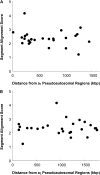Extensive divergence between mating-type chromosomes of the anther-smut fungus
- PMID: 23150606
- PMCID: PMC3527253
- DOI: 10.1534/genetics.112.146266
Extensive divergence between mating-type chromosomes of the anther-smut fungus
Abstract
Genomic regions that determine mating compatibility are subject to distinct evolutionary forces that can lead to a cessation of meiotic recombination and the accumulation of structural changes between members of the homologous chromosome pair. The relatively recent discovery of dimorphic mating-type chromosomes in fungi can aid the understanding of sex chromosome evolution that is common to dioecious plants and animals. For the anther-smut fungus, Microbotryum lychnidis-dioicae (= M. violaceum isolated from Silene latifolia), the extent of recombination cessation on the dimorphic mating-type chromosomes has been conflictingly reported. Comparison of restriction digest optical maps for the two mating-type chromosomes shows that divergence extends over 90% of the chromosome lengths, flanked at either end by two pseudoautosomal regions. Evidence to support the expansion of recombination cessation in stages from the mating-type locus toward the pseudoautosomal regions was not found, but evidence of such expansion could be obscured by ongoing processes that affect genome structure. This study encourages the comparison of forces that may drive large-scale recombination suppression in fungi and other eukaryotes characterized by dimorphic chromosome pairs associated with sexual life cycles.
Figures


References
-
- Abbate J., Hood M. E., 2010. Dynamic linkage relationships to the mating-type locus in automictic fungi of the genus Microbotryum. J. Evol. Biol. 23: 1800–1805 - PubMed
-
- Antonovics J., Abrams J., 2004. Intratetrad mating and the evolution of linkage relationships. Evolution 58: 702–709 - PubMed
-
- Bakkeren G., Kämper J., Schirawski J., 2008. Sex in smut fungi: structure, function and evolution of mating-type complexes. Fungal Genet. Biol. 45: S15–S21 - PubMed
-
- Bergero R., Charlesworth D., 2009. The evolution of restricted recombination in sex chromosomes. Trends Ecol. Evol. 24: 94–102 - PubMed
Publication types
MeSH terms
LinkOut - more resources
Full Text Sources
Molecular Biology Databases

